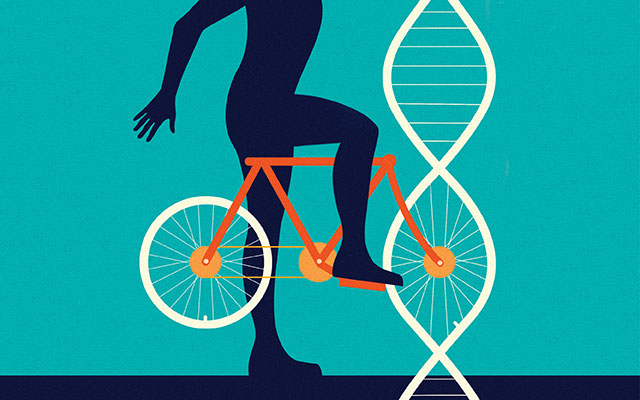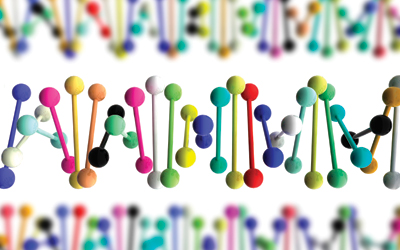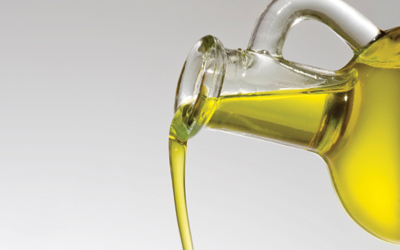We’ve long known that exercise boosts our health and fitness but haven’t well understood how it works at the genetic level. Now new research by the Swedish Karolinska Institutet is beginning to unravel the mystery of how exercise alters the function of our genes.
For the study, 23 men and women pedaled stationary bicycles with just one leg for 45 minutes four times weekly for three months; their other leg was unexercised and acted as a control. Researchers took muscle biopsies from each leg before and after the training period.
Not surprisingly, endurance improved in the exercised legs. But the training also changed their muscle cells at nearly 5,000 sites across the genome.
One key epigenetic change that exercise effected was methylation, a complex biochemical process that controls protein and DNA synthesis throughout the body, among hundreds of effects. Other positive gene-level impacts of the training were improved insulin and inflammatory responses.
The findings may someday help us optimize our training efforts based on our individual genetic profiles, says senior author Carl Johan Sundberg, MD, PhD.
The study may also have broader implications for treating conditions like type 2 diabetes and cardiovascular disease, which are influenced by an individual’s degree of physical activity, he says.
Q&A With Carl Johan Sundberg, MD, PhD, and Maléne Lindholm, PhD
Gain more insight into this research from our Q&A with coauthors Carl Johan Sundberg, MD, PhD, a professor of molecular exercise physiology at the Swedish Karolinska Institutet, and Maléne Lindholm, PhD student at Karolinska Institutet.
Experience Life | How does this study help us better understand how exercise affects the human body?
Carl Johan Sundberg | For decades the question has not been whether exercise does anything to the human body or whether it’s beneficial, but rather how does the body interpret the signals from a training session, or for that matter, from any type of environmental change. This study really brings us some understanding of how the body reads changes in the internal environment. Hopefully this can be helpful in order to optimize training so we don’t think about exercise as just one-size-fits-all, because we are all different from a genetic perspective so some people may react stronger to certain types of exercise than another one, and another person may react in a different way. Down the line, we may be able to select how we spend our time on what exercises and how it will benefit us individually.
Also, if we look on the fundamental mechanisms that this is part of, it may be that we could mimic some health effects of physical activity through various types of new pharmaceutical drugs for people that cannot move, are immobilized for neurological reasons, paralyzed, or have severe pain such as joint pain — in such a way they may benefit from some of the benefits other people get from exercise.
EL | Why is methylation important and how does it effects our genes?
Maléne Lindholm | DNA methylation is a modification on our DNA that affects how we are able to use our genes. Genes are copied and these copies are then translated into functional proteins in our cells. The degree of methylation affects how active a gene is (i.e. how many copies are made) and thereby how many proteins are produced. Depending on where in the genome the methylation is, it can either increase or decrease gene activity.
CJS | We have about 21,000 genes that encode the templates for the proteins that basically make up the functions and structures of our cells and body. Those genes can be copied and translated into proteins to higher or lower degrees depending on how the genes are made accessible for copying. The accessibility of a gene is largely regulated through epigenetics, so a gene can be made less or non-accessible through, for example, DNA methylation of the so-called promoter region so that it’s blocked for any type of kickstarting signal. Or it can be made more accessible through de-methylation.
In muscle, lifestyle can influence the degree with which a gene is accessible or not, so training seems to be very able to influence the methylation pattern.
EL | You noted epigenetic differences between male and female skeletal muscle from the endurance training: Can you explain this?
CJS | The reactions to the training were similar. But there were baseline differences between men and women and they were very consistent, but that is most likely due to differences in sex hormone profiles, even though it is tricky to extract from the data. We know too little about the regulation of genes at present.
EL | You have said that these findings “could be of great importance for the understanding and treatment of many common diseases such as type 2 diabetes and cardiovascular disease.” Can you explain how this might work?
CJS | These are two examples of diseases that are strongly influenced by the degree of physical activity and the fitness level of an individual — and there are many other diseases as well. A large fraction of the diabetes and cardiovascular disease we see today are due to lifestyle. It is estimated from some recent studies that 80 percent of all diabetes and cardiovascular disease could be prevented through “idealized” lifestyle: for example, no smoking, drinking moderately, maintaining a healthy bodyweight, eating a reasonable diet, and the largest contributing factor of becoming physically active. Therefore by understanding how physical activity plays into health — and not only cardiovascular disease, but also diabetes, cancer, and the like — we believe these findings can help us in our understanding and thereby increase preventive treatment of the diseases.
EL | What do you see in the future for epigenetic testing and our health?
CJS | There are such intriguing mechanisms that are so sophisticated and smart in the way that human cells reads changes in environment and through extremely advanced and multi-faceted molecular events basically mediate the way that the tissues adapt and improve our functional health. In 10 or 20 years, I think there will be tests available that could guide people on what type of exercise they may best benefit from.



This Post Has 0 Comments